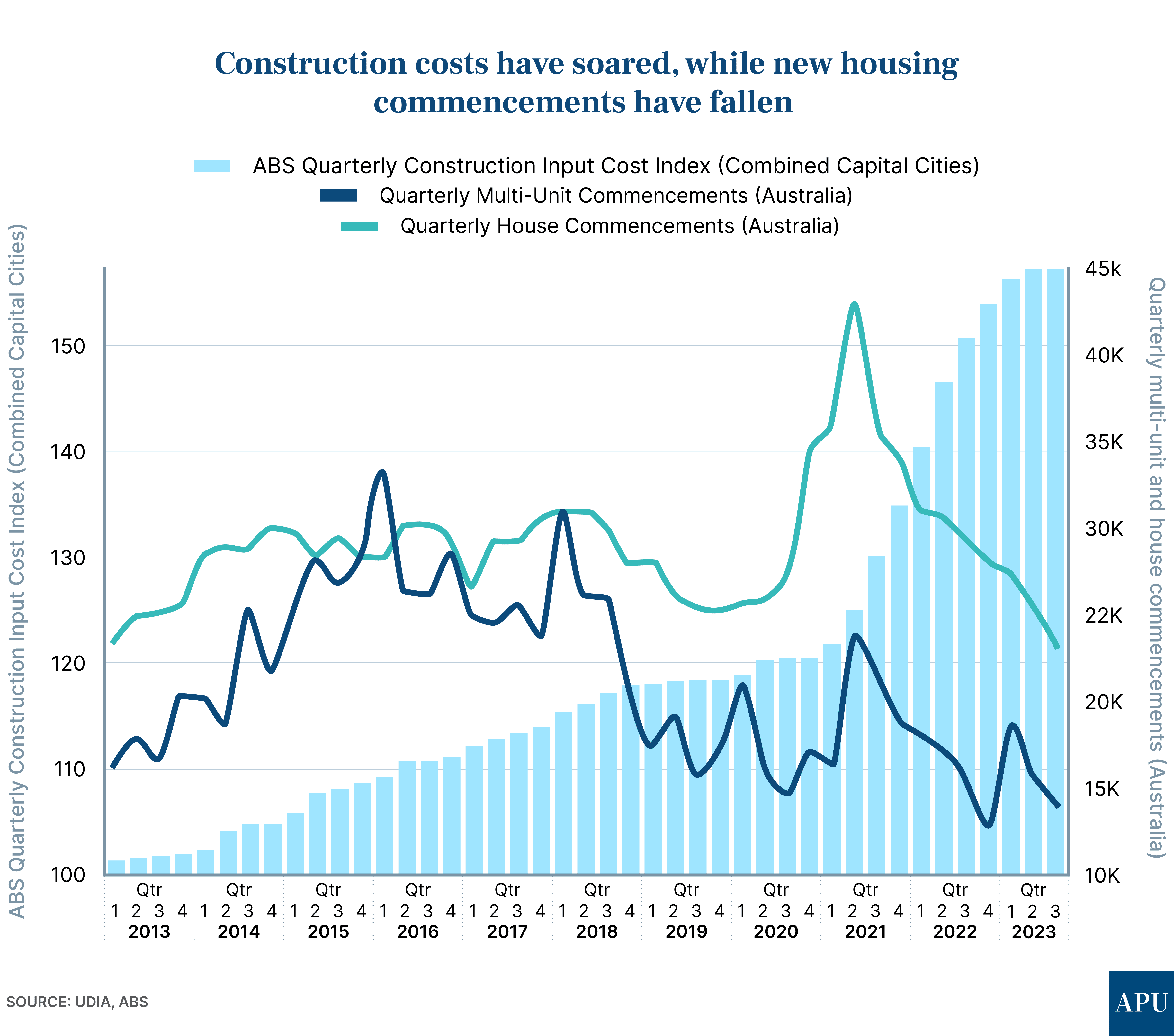Features > Property News & Insights > Housing Trends
Want to build 1.2 million homes in 5 years? You’ll need 90,000 extra tradies

KEY POINTS
- BuildSkills Australia says Australia needs to build 60,000 new homes every quarter over the next five years if the national target of 1.2 million new homes is to be met
- At the moment, BuildSkills says only 43,000 homes are being completed every quarter
- The government-backed body says 90,000 more construction workers are needed to help bridge the gap
Governments have been warned they’ll need to find 90,000 extra construction workers quickly if the national target to build 1.2 million affordable and well-located homes over the next five years is to have any hope of being met.
In the face of high population growth and a deepening housing crisis, the federal and state governments agreed to the ambitious target in August last year.
But with just over three months to go until the five year time-frame starts on the first of July, the organisation set up to help solve construction workforce shortages says there’s a huge shortfall of workers.
The problem

BuildSkills Australia was set up by the federal government to work with industry and unions to find solutions to the workforce challenges facing the construction, property, and water industries.
The body has warned that for the National Housing Accord targets to be met, construction needs to lift from 43,000 completed homes per quarter to 60,000.
In order to do that, BuildSkills says Australia needs to find another 90,000 construction workers.
The Executive Director of Research and Planning at BuildSkills, Robert Sobrya, says it’s clear those workers can’t be found in the next three months, but he says it’s not impossible to drastically speed up construction of homes so the five-year target can be met.
“The uplift is significant, but it has been done before,” he says, pointing out that in the apartment boom between 2016 and 2018, “we did see that level of uplift, but not this quickly and for this amount of a sustained period.”
So what happened during the apartment boom?
“There was a huge uptick in apprenticeships,” he says and “we just diverted people from other parts of the economy to come and work in construction.”
“There are a lot of people sitting on the sidelines that aren't in a given industry at a given time.”
“When the conditions are right and the pay signals are right, people get sucked in,” Mr Sobrya told ABC Radio.
So is it just a case of having to pay people the type of huge FIFO wages that were prevalent during the mining boom?
“This time around, it's probably a more nuanced approach because this is all happening in built up existing areas,” he says, “so levers like migration, getting more women in the construction, convincing more school leavers that the trades are an excellent pathway relative to a university pathway - all those things are important.”
Import tradies? Not so easy…
Construction industry lobby group Master Builders Australia says the warning from BuildSkills aligns with the views it is hearing from members, who currently cannot get enough workers to complete the jobs they already have.
In fact, the commencement of new housing is actually falling, as building costs have blown out.

Master Builders chief executive Danita Wawn says a “radical change” is needed “in the way upon which we are looking at our migration system, and our skill recognition system to support a fast-tracked migration solution."
But BuildSkills’ Robert Sobrya warns “The issue with migration is…everyone who comes in also needs a home.”
He says there needs to be a better mix in the migration system.
“As it stands, it's actually quite a low percentage of migrants who come in and work as engineers and trades people and builders.”
Mr Sobrya and Master Builders agree better recognition of the qualifications of migrants who are already here is needed.
“We know that there are a large number of tradies in this country that can't get their licences recognised, it's too expensive and too cumbersome for them,” Denita Wawn says.
Robert Sobrya also says there are other barriers for qualified migrants that aren’t always readily apparent.
“Engineers Australia did a great report a couple of years ago where they interviewed a bunch of recent migrants who had actual accredited, certified Australian qualifications in engineering.”
“They were going around driving Ubers because they just couldn't crack into our industry,” he says.
“There's something about the culture of the industry and the way we recruit people - it's really hard to get into construction unless you know someone who will vouch for you.”
“We need to loosen up the frictions that are in the social operating system of the industry as much as anything.”
The takeaway
The Federal Housing Minister Julie Collins agrees governments have set themselves an ambitious housing target, but claims they’re “getting on with the job.”
Asked if it's unrealistic to expect Australia to quickly make up a shortfall of 90,000 tradies, BuildSkills Robert Sobrya gives this careful answer:
“I wouldn't use the word unrealistic, but there's no denying it; it's ambitious.”
“But ambitious is precisely what's needed with the housing market in the current state that it's in.”
Master Builders Denita Wawn, however, is not holding back.
“It needs to be raining tradies,” she says bluntly.
Stay Up to Date
with the Latest Australian Property News, Insights & Education.




.png?width=292&height=292&name=Copy%20Link%20(1).png)
 SIGN UP FOR FREE NEWSLETTER
SIGN UP FOR FREE NEWSLETTER








.jpg?width=1920&height=1080&name=Warning%2c%20You%20Might%20Be%20Facing%20Higher%20Taxes%20Soon%20(1).jpg)





.png?width=1920&height=1080&name=Rate%20Drops%20Signal%20BIGGEST%20Property%20Boom%20in%20DECADES%20(1).png)

.jpg?width=1920&height=1080&name=Labor%20vs%20Liberal%20These%20Housing%20Policies%20Could%20Change%20the%20Property%20Market%20Forever%20(1).jpg)
.jpg?width=1920&height=1080&name=QLD%20Slashes%20Stamp%20Duty%20Big%20News%20for%20Investors%20%26%20Home%20Buyers%20(1).jpg)
.jpg?width=1920&height=1080&name=Trump%20Just%20Slapped%20Tariffs%20%E2%80%93%20Here%E2%80%99s%20What%20It%20Means%20for%20Australia%20(1).jpg)
.jpg?width=1920&height=1080&name=Federal%20Budget%202025%20More%20Debt%2c%20No%20Housing%20%E2%80%93%20Here%E2%80%99s%20What%20You%20Need%20to%20Know%20(1).jpg)
.jpg?width=1920&height=1080&name=Australias%20Housing%20Crisis%20is%20about%20to%20get%20MUCH%20Worse%20(New%20Data%20Warns).jpg)
%20(1).jpg?width=1920&height=1080&name=Australias%20RENTAL%20CRISIS%20Hits%20ROCK%20BOTTOM!%20(2025%20Update)%20(1).jpg)
%20(1).png?width=1920&height=1080&name=Is%20Adelaide%20Still%20a%20Good%20Property%20Investment%20(2025%20UPDATE)%20(1).png)
.jpg?width=1920&height=1080&name=RBA%20Shocks%20with%20Rate%20Cuts!%20What%E2%80%99s%20Next%20for%20Property%20Investors%20(1).jpg)
%20(1).jpg?width=1920&height=1080&name=I%20Predict%20The%20Feb%20Rate%20Cut%20(My%20Price%20Growth%20Prediction)%20(1).jpg)
.png?width=1920&height=1080&name=Why%20Property%20Prices%20Will%20Rise%20in%202025%20Market%20Predictions%20(1).png)
.jpg?width=1920&height=1080&name=Why%20Investors%20Are%20Choosing%20Apartments%20Over%20Houses%202%20(1).jpg)
.jpg?width=1920&height=1080&name=Why%20Rate%20Cuts%20Will%20Trigger%20A%20Property%20Boom%20(1).jpg)
.jpg?width=1920&height=1080&name=Retire%20On%202Million%20With%20One%20Property%20(Using%20SMSF).jpg)
.jpg?width=1920&height=1080&name=4%20Reasons%20Why%20You%20Should%20Invest%20in%20Melbourne%20Now%20(1).jpg)
%20(1).jpg?width=1920&height=1080&name=Old%20Property%20vs%20New%20Property%20(Facts%20and%20Figures%20Revealed)%20(1).jpg)
%20(1).jpg?width=1920&height=1080&name=Will%20The%20New%20QLD%20Govt%20Create%20a%20Property%20Boom%20or%20Bust%20(My%20Prediction)%20(1).jpg)
%20Scott%20Kuru%20(1).jpg?width=1920&height=1080&name=Inflation%20Hits%20Three-Year%20Low%20(Will%20RBA%20Cut%20Rates%20Soon)%20Scott%20Kuru%20(1).jpg)
.jpg?width=1920&height=1080&name=How%20to%20Buy%20Investment%20Property%20Through%20SMSF_%20The%20Ultimate%20Guide%20(1).jpg)
.jpg?width=1920&height=1080&name=Victoria%20Slashes%20Stamp%20Duty%20Melbourne%20Set%20to%20Boom%20Scott%20Kuru%20(1).jpg)
.png?width=1571&height=861&name=Are%20Foreign%20Buyers%20Really%20Driving%20Up%20Australian%20Property%20Prices%20(1).png)
.jpg?width=1920&height=1080&name=The%20Single%20Factor%20That%20Predicts%20Property%20Growth%20Regions%20(1).jpg)
%20Scott%20Kuru%20(1).jpg?width=1920&height=1080&name=My%20Prediction%20On%20Rates%20%26%20Negative%20Gearing%20(Market%20Crash)%20Scott%20Kuru%20(1).jpg)

-1.png?width=1920&height=1080&name=Major%20Banks%20Cut%20Rates%20Will%20RBA%20Follow%20Suit%20(Sept%20Rate%20Update)-1.png)
%20Scott%20Kuru-1.png?width=1920&height=1080&name=Rate%20Cut%20Coming%20What%20New%20Zealands%20Move%20Means%20for%20Australia%20(Sept%20Prediction)%20Scott%20Kuru-1.png)
%20(1).jpg?width=1920&height=1080&name=Buy%20when%20the%20interest%20rates%20are%20high!%20(Why%20you%20must%20buy%20now!)%20(1).jpg)
.jpg?width=1920&height=1080&name=Carms_Revised%20Taxes%20Due%20Aug%209%20YT%20Thumbnail02%20(1).jpg)
.jpg?width=1920&height=1080&name=Carms_Too%20Little%20Too%20Late%20Aug%207%20YT%20Thumbnail01%20(1).jpg)









.jpg?width=1920&height=1080&name=Carms_Rate%20Drop%20In%20July%20Jun%2010%20YT%20Thumbnail02%20(1).jpg)
.jpg?width=1920&height=1080&name=Carms_Own%20a%20Property%20V6%20Jun%205_YT%20Thumbnail%20(1).jpg)









.png?width=1920&height=1080&name=Artboard%201%20(3).png)






.jpg?width=1920&height=1080&name=YT%20thumbnail%20%20(1).jpg)

